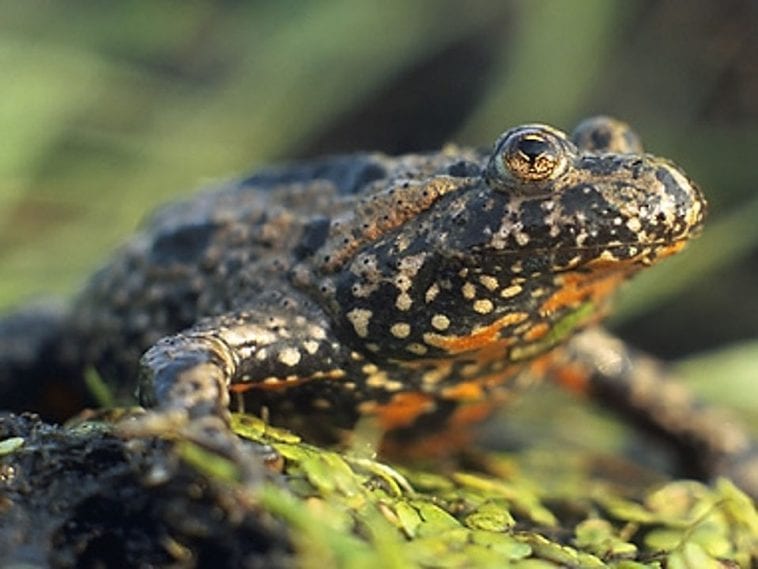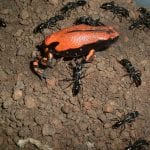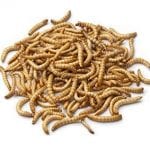Cute and colorful frogs are kept as precious pets. It’s easy to like a frog as a pet; you can take it anywhere, and these are always willing to be held as long as you train it early. Taking care of a frog is also easy compared to other pets like reptiles, birds, and the usual furry mammals. The key to successfully care for a frog is to provide the best food so it can grow healthy and happy in captivity.
Before taking a frog and other amphibians
Before you purchase a frog to be your pet, consider that this is a carnivorous animal. Be ready to handle live prey, especially insects, to feed your pet. If you are not up to handling insects, then better go with another pet. A frog has to eat fresh or alive prey, and you, as its owner, have to give it to him. And if you are not squeamish about this at all, then it’s time to learn what and how to feed a frog and other amphibians.
What will a frog eat?
A frog’s diet depends on what species it is, the frog’s age, the number of frogs in the enclosure, and the frog’s breeding status. All adults need a steady diet of fresh insects. Some larger frog and amphibians require small vertebrates like pinkie mice, and these should be alive, not frozen.
In the wild, frogs are considered opportunistic breeders that mean that they will eat anything that comes their way. Therefore, the food you give to your pet should be similar to the food that it can get in the wild. Experts say that it takes more than just dropping a few insects inside the frog’s tank.
Frogs are diverse creatures, and therefore there is no one size fits all style of feeding them. Despite crickets as being the most common food for frogs, you must still offer a varied diet, which usually includes mealworms, locusts, grasshoppers, and for larger frogs, pinkie mice. Live reptile food is always available from a pet store which you can use to feed your pet. And if you want to cut down on food costs, you can raise your own live food. If you have a spare room or area in your garage, set up a container where you can raise worms, crickets, or fruit flies. These are easy to raise and will be safe to feed your precious pets.
To summarize, frogs will eat crickets, flies, worms, spiders, grubs, snails, slugs, pinkie mice, lizards, snakes, small fishes, and other toads.
How often to feed frogs?
The frequency and the amount of food depend on the species of frogs and toads you have. Some frogs and toads species have very high energies, such as dwarf frogs. Therefore, you must have live food available inside their enclosures at all times. Other frogs have a sedentary nature like White tree frogs, and these require feeding only a few times a week while some only every other week.
Frogs are prone to obesity and overeating. These creatures will eat until these are out of food, which can make them sick. This is why you should give high-calorie food or calorie-dense food in moderation. As a rule, give an adult frog 5 to 7 crickets or other types of insects several times in a week. Juvenile frogs should be fed once a day. Young frogs need a lot of protein to help it grow larger and healthier, while adults may not need as much protein because they have already attained their adult size and weight.
Are vitamins and supplements necessary?
A frog cannot produce vitamin A, and this is important in the frog’s many different metabolic processes. Therefore, the food you feed your pet should be rich in vitamin A. While insects that a frog eats or where it gets most of its nutrients to have very little vitamin A; you can supplement by gut loading prey with vitamin A-rich foods. You can gut feed crickets, grasshoppers, and pinkie mice with sweet potato or other commercial gut-load food dusted with vitamin A supplements.
You must also dust food with calcium and phosphorous powder, which are available in most pet stores or from your vet. Rotate supplement feeding by dusting prey with calcium every other day and vitamin A or phosphorous every other day.
Don’t give supplements intended for humans! You might be tempted to grind some calcium tablets to sprinkle over your pet’s food, so don’t! Supplements made for pet frogs and toads are available from pet stores and pet shops. Just follow the instructions on how to give this to your pet, and you’re done!
Can frogs suffer from accidental ingestion?
Frogs and toads can accidentally ingest small bits of gravel or sand when it tries to scoop the food from the enclosure floor. So, it’s important to use digestible surface matter like Astroturf. Felt can also be used because toads and frogs won’t be able to ingest this as it takes prey from the floor of the enclosure.
You can also prevent accidental ingestion by not using any substrate on your tank, only smooth stones, and slabs. However, most frog keepers and owners prefer to use the substrate to help maintain the right temperature and humidity inside the tank.
How large or how small food should be?
There is a general rule in feeding frogs, toads, lizards, and other amphibians. Small insects and prey should be no larger than the width of the head or the distance of its two eyes. If you overlook this, your pet can suffer from intestinal impaction. Your frog can die if this is overlooked.
What food to never give your frogs?
There are foods that are perfect for frogs, and there are also foods that should never be given to frogs. These creatures are meat-eaters, and thus, it won’t eat any plant, fruit, or vegetable. Do not feed your pet live caught food such as insects, worms, mice, and other prey. These may contain pesticides or may have parasites that can cause diseases.
Never give frogs human food, cooked food, food that is too large, and food that contains artificial components or ingredients. Some spices and sauces are not good for frogs, and eating these can lead to dangerous effects.
Do frogs drink?
Frogs should be given enough fresh water to drink every day. Water should be safe and has been de-chlorinated. Tap water may be used as long as you treat it to remove chlorine. There are effective de-chlorinator products available from a local pet shop or from an online store.
You must also check your water for other metals and elements which can make your pet sick. You can visit your local water office, or you can conduct your own water quality test using kits purchased online.
But how do frogs drink water? Frogs don’t sip from a water bottle or from a bowl of water; they drink water in the form of moisture through their skin. Frogs and toads have patches of skin that allow them to drink in their abdominal area.
You can spray the tank with water to make sure that your pet is getting adequate hydration. This will also help improve humidity inside the tank, which frogs love. Spray or mist the tank at least once or twice a day. Apply water on the wall or on the accessories like plants and stones. Never mist your frogs directly.
What to feed a wild toad?
Just like frogs, toads and wild toads will eat anything that can fit inside their mouths. Also, wild toads are found all over the world, and thus, these animals have different habitats. Toads will grow larger than frogs and thus will eat mice and lizards. And just like frogs, toads swallow their food whole because it does not have a teen and they can’t chew as well.
How do frogs and toads eat?
Frogs and toads eat in a very unusual way. As mentioned a while ago, these creatures don’t have teeth and hence will not be able to chew its food. A frog will swallow its prey whole. But swallowing is a complicated matter because it does not have the proper muscles to do this, and hence, it will gulp the food down using its hands, feet, and eyes. This is the reason why toads and frogs close their eyes when they swallow food.
But before food is swallowed, it has to be picked from the ground, and frogs don’t have the best limbs for this as well. The frog will use its long, thick and sticky tongue to pick up food from a distance and also to sense the air for nearby prey. The long and sticky tongue acts as an extra limb, too, as it can pick up food delicately from the floor. Frogs and toads know if their tongues can reach their prey, but sometimes it’s a hit or miss. They will never give up and try again if they were not successful the first time.
It’s also possible for frogs to just use their head and mouth to pick up food from the floor. If the food is nearby, it does not have to use its tongue to get it. Some frogs are able to use their hands to hold on to food so they can eat efficiently. Their hands are not for holding on to food as they eat, but it can control the live insect prey as it tries to escape from the frog’s grip.
How long can frogs and toads go without eating?
It actually depends on the metabolism of the frog. If a frog is very active and has a high metabolic rate, like small dart frogs, these must be fed daily with one or two insect prey. This type of frog may die if you don’t feed it a day or two.
Meanwhile, some frogs have a low metabolic rate and hence don’t move as much. This frog prefers to be sedentary and hence require only once a week or once every other week feeding. This kind of frog can go weeks without eating anything.
Now that you know how long will a frog or toad goes without eating, you can’t take your pet for granted if you want to leave home, leaving your pet behind without food. If you have to leave for an extended period, have someone look after your pet. He should know when to feed your pet, what not to feed your pet, and to contact you or your vet in case of any emergency.
What do tadpoles and juvenile frogs eat?
Tadpoles eat small aquatic plants and animals. Since frogs deposit their eggs near water, these will hatch, and the tadpoles immediately swim in the water to look for food. These babies may be small but have a voracious appetite and will eat anything that can fit in their mouths.
As the tadpoles become young, their diets switch from being omnivores to solely carnivores. Despite their size, they are able to move towards prey and eat them. And just like tadpoles, anything that can fit the juvenile frog’s mouth is considered food.
Juvenile frogs will now have highly developed tongues to capture all kinds of prey, including flies, crickets, and worms.
Why do frogs and toads eat other frogs and toads?
Adult frogs and toads may eat their kind, but this is not a battle for territory or aggressive behavior among species. This is simply survival. If a toad is hungry and it sees a smaller toad or frog nearby, it will eat it. It won’t hesitate to eat anyone and will simply do so because it’s hungry.
But don’t worry because not all toads and frogs are this way. You can still have a frog or toad as a pet without worrying that it will eat it’s cage mates. The key is to always have some food to offer. Don’t overlook your pets, especially when you have to leave them behind for just a day.
When to take your pet to the vet and more feeding tips
It’s not so easy to tell if your pet frog needs medical attention. Unlike pet dogs or cats, which we can readily tell if they need to go to the vet. You need to be a careful owner and take time to get to know your pet so you can tell if it needs help or not.
Some frog pet owners were kind enough to share their experiences online and recommended that pet owners monitor their frogs every time they introduce a new food. There are many other tips to remember
- New food is an experience for frogs. Take time to see if he is okay with the new food before introducing lots of it. As mentioned, your pet won’t know it’s full because it does not sense it. Feed one serving of the new food and let it eat and digest it. Depending on your pet’s metabolism, find out if he is okay with the food, or you should give something else. If he does not show symptoms like runny stools, vomiting, or lack of energy, then you can go ahead and feed it more.
- Some frogs show their feelings through their colors, and this is also a good way to identify if your pet needs to visit the vet. Consider that a bright red and black frog that has turned dull may indicate that it needs help right away. Aside from color, look for weakness and lack of appetite. Take it to an exotics vet at once.
- Frog food can be purchased from a pet shop, but you need to be keen on the quality of food you are feeding your pet. Feed your pet only quality, pesticide-free, organic, alive food. Don’t buy a lot of food unless you’re planning to feed it all to your pet. Fresh food is always better no matter what kind of food you are offering.
- If you have a new frog, don’t immediately introduce it to other frogs in the enclosure because this may carry pests and other diseases. As mentioned, some owners carelessly feed their pets unsafe food like wild-caught food. These may contain toxins, chemicals, and pests that can affect your pet frog. As much as possible, place the new frog under quarantine. Leave it under quarantine for at least two to three weeks. This is enough time to wait to monitor your pet against illnesses, parasites, or any kind of health condition.
Your frog can grow healthier and happier when it eats the right food and is fed properly. In the wild, frogs and toads use instincts to find food and to eat. So as much as possible, create an environment similar to its natural environment to enhance your pet’s natural instincts even in captivity. Let insects run loose inside the enclosure so your pet can chase after it. Make feeding time a challenge.



